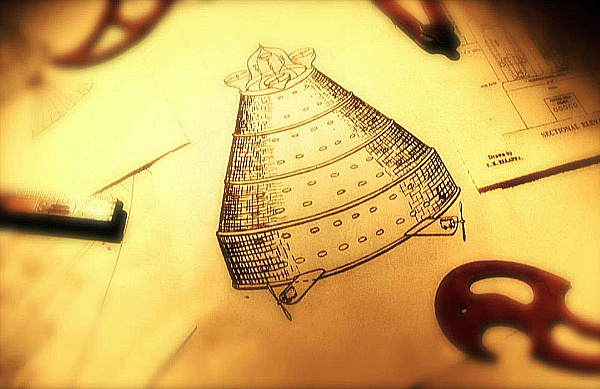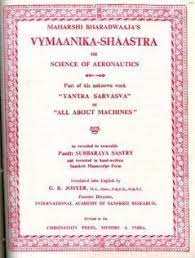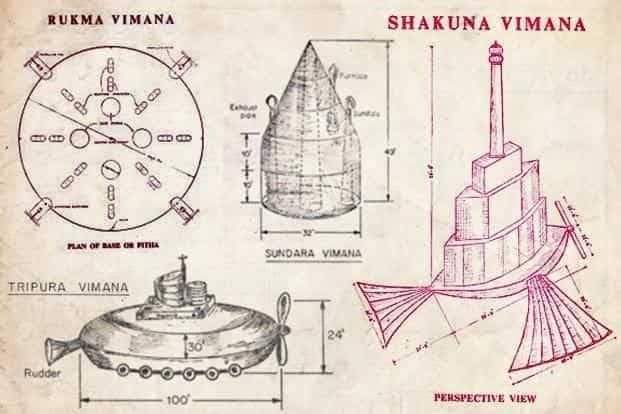
On 28 June 1951, The then Maharajah of Mysuru inaugurated the International Sanskrit Research Centre in Mysuru. Chief Minister of Mysuru State, Sri C K Reddy, was in attendance.
G R Josyer was the Director of that Research Centre. The guests were shown all the rare collections of Sanskrit scriptures and literature painstakingly gathered from various sources. It was indeed an impressive collection. But there was one small handwritten notebook that surprised them the most. What were the contents of that book?
The title of the book was
" Vaimanika Shastra of Maharishi Bharadhwaj "
For the guests or the audience, this was a strange title, and they had never heard about it before. What further surprised them was the person who brought this book from Bangalore informed them that this was the first of the collection of 22 such notebooks, all handwritten by one Venkatachala Shastri as dictated by Anekal Subbaraya Shastri. The book contained 6000 lines in Sanskrit with thousands of Shlokas in Sanskrit. What was the reference scripture for such a mammoth literary work?
There was none. This knowledge was verbatim transferred by Maharshi Bharadwaj to Subbaraya Shastri through ''psychic channeling''; that was what was told to the amused audience.
G R Josyer subsequently translated this book from Sanskrit to English.
The date mentioned in the first notebook is 1/8/1918, and the last book has a date of 23/8/1923.
So let'slet's first learn the background of this author, Sri Subbaraya Shastri.
Subbaraya hailed from Togare Agrahara in Hosuru near Bengaluru.
As if the poverty wasn'twasn't enough, almost the entire family suffered from leprosy. Many in the family succumbed to the disease. Subbaraya left home and moved into the forest in the Avani region near Kolar. There he met with a sage through whom he learned the basics of Sanskrit. There were no books or scriptures for reference; all the learning was verbal and one on one, like true Upa-Nishad style.
Then followed hours of deep meditation. As the practice of meditation got intensified, mind channeling was practiced. Subbaraya became a bridge between many Maharishis through psychic channeling. Maharshi Bharadwaja and Rishi Gautama became the main source of knowledge in subsequently developing some hitherto unknown knowledge about "Jala Tantra," "Bhoutika Kala Nidhi," and "Yantra Sarvasva."
Vaimanika Shastra was part of Yantra Sarvasva. All these works were verbatim recited and dictated by Subbaraya Shastri to Venkatachala Shastri after he came out of the forest and started living in Anekal near Bengaluru. When his book Vimana Shastra was raising many eyebrows, Britishers jailed him under the pretext of him being a freedom fighter. Within a few months of imprisonment, Shastri died due to prolonged illness; he passed away in utter penury. This ended the life of a great scholar and researcher.
 What happened to all his works, then? Fortunately, some well-wishers saved all his work safely when G.R. Josyer got to know about his works and sought permission to translate some of them into English.
What happened to all his works, then? Fortunately, some well-wishers saved all his work safely when G.R. Josyer got to know about his works and sought permission to translate some of them into English.
Vimana Shastra was one of them.The book was priced at 160 dollars in those days (around 1972); still, there were so many buyers all over the world. Even NASA in the USA got hold of a copy of this book. While the entire world is convinced that the Wright brothers were the pioneers of aviation, here is a book that portrayed India as indeed having the knowledge of flying vehicles called Vimanas from ancient times. The book even produced certain mind-boggling details of construction, the working of engines, and gyroscopic systems, which were developed much later in aviation technology. NASA actually undertook an experiment on the construction of mercury vortex engines, very similar to what was written in Vaimanika Shastra.
Pushpak Viman is a well-known aerial vehicle that Ravan used. He had used it to take Sita away to Lanka, and after slaying Ravan, Sri Ram returned to Ayodhya along with Sita, Lakshman, and Vibhishan in the same Pushpak Viman. This is elaborately mentioned in Ramayana, and that was in Treta Yug. Is there any mention of such vehicles in other times, any other scriptures?
As per Maharshi Bhardwaj, Vimanas were classified as per the Yugas.
During the Krita yuga, Dharma was established firmly. Each one possessed daivatva, divinity embedded in their persona. These qualities of righteousness empowered some of them in many ways. Munis, Maharshis, and Rishis possessed ''Ashta Shakti'' and these are;
Anima.. Ability to be invincible
Mahima..Ability to be of enormous
Garima.. Ability to be heavy like a rock
Laghima.. Ability to be lighter than air
Prathyah..Ability to be contended
Prakamya.. Ability to fulfill one's wish
Ezhava.. Ability to be divine
Vashitva..Ability to make others surrender.
Essentially they could assume any form at any given time. ''Laghima'' gave them the power to be lighter than air, and they were able to levitate and also travel individually freely in the air.
Coming to Tretayug, Dharma had declined considerably. Few of them possessed very strong ''mantra shakti,'' and they were able to develop and fly their Vimanas. They were called Mantrika Vimanas. Pushpak Vimana was one of the 25 types, and others were Ajamukh, Brajasvat, Jyotirmukh, Ujvanga, Kolahal, Tripura, etc.
While in Dvaparyug, there were 56 types of Vimanas. Bhairava, Nandaka, Vatuka, Vishnuratha, Bruhathyunjya etc. During this yuga, Tantrik Shakti was very dominant; hence the Vimanas were referred to as Tantrik Vimanas.
At present, yuga, Kaliyuga, both Mantra, and Tantra Shakti are on the decline, and the ability to control the Vimanas has been lost. Artificial Vehicles were built, which are called Kritaka Vimanas.

There is an elaborate description of how various types of Vimanas were built, like Rukma, Mandala, Shakuna, Padmaja, Pushkara, etc. The pilots were referred to as "Rahasya gnyanadhikari"...The one who has the secret knowledge of flying. The 32 secrets were contained in the training manual for pilots.
There is mention of mercury and solar energy used as fuel. Electrical motors and gyroscopes are explained in detail. NASA started experiments on some of the aspects mentioned in this book. After sustained efforts sometime around 1978, they successfully used Mercury Vortex engines by ionizing the mercury gases, exactly as explained in Vaimaika Shastra.
There was a big lobby ridiculing it as trash, and as expected, it was our own people, Indians, and organizations based in our country who were at the forefront without even reading a page from the book.
This is not just one book in isolation narrating aviation knowledge in ancient India.
The ancient Indian texts on Vimanas are so numerous it would take volumes to relate what they had to say. The ancient Indians, who manufactured these ships themselves, wrote entire flight manuals on the control of the various types of Vimanas, many of which are still in existence, and some have even been translated into English. The Samara Sutradhara is a scientific treatise dealing with every possible angle of air travel in a Vimana. There are 230 stanzas dealing with the construction, take-off, cruising for thousands of miles, and normal and forced landings.
Now the question is, being a pilot myself, flying one of the advanced airplanes like Airbus 320, do I believe all this? Well, there is no reason not to, for right from ancient times, we had such in-depth knowledge of Astronomy, mathematics, and Ayurveda, which the rest of the world has discovered in recent times. Unfortunately, this knowledge was either hidden or destroyed by the barbaric invaders resulting in just a fraction of that great knowledge being available to us now. In 1202 Baktiar Khilji burnt the three-storied library building at Nalanda University, and nearly 90 lakh manuscripts were burnt. Similar was the fate of Takshashila and the libraries of Kashmir, which Adi Shankara used to write his books. We don'tdon't know what great knowledge was buried under those burnings.
NEXT ARTICLE

At the southernmost tip of this mesmerising ensemble lies the majestic Great Nicobar Island, boasting an impressive landmass of about 910 square kilom...

Bharath has always been a land traversed by spiritual masters/ Guru since time immemorial. These spiritual masters have always upheld the core princip...

South India contains its fair share of unique pilgrimage centres. These divine places of worship have a prominent Sthala Purana, devoted followers, di...